Research Division
Reprinted from "INSULATORS - Crown Jewels of the Wire", July 1973, page 21
Photo sent in by Esta Brown. These are all the different CD numbers of the
N.E.G.M.'s that she knows of except the CD #250 owned by N. R. Woodward. Do you
know of any others??
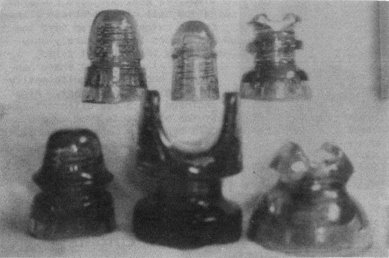
N.E.G.M.'s
Dear Dora, Editor:
I am enclosing a picture of a crudely made white porcelain insulator which
I recently picked up.
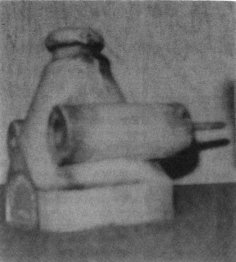
On the front there is a recessed oval shape on which is embossed WESTINGHOUSE
S-29865 A. It is 5-1/4" wide, 5-1/2" high, 4" deep and is
threadless. There are two large wood screws which project through the back.
I would be interested in any information you or your readers could give me
through CROWN JEWELS.
Sincerely,
Edward Doherty
San Mateo, California
- - - - -
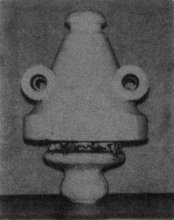
Dear Ed
I believe what you have pictured is one half of a porcelain transformer
cutout. I also have one like yours (see picture), only mine has the pull out
switch handle. I understand these handles or knobs broke quite easily while
being pulled apart. Also enclosed are a few different styles of cutouts from my
old catalogue from Canada. My cutout is also embossed exactly the same as yours.
Dora
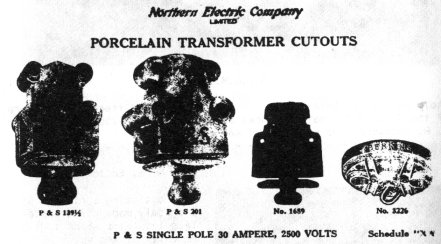
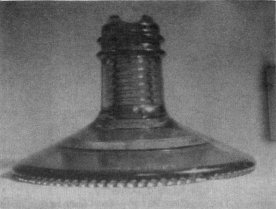
Dear Dora,
Enclosed find photo of an insulator which may be of interest to your readers.
I bought this at the Chicago show in October.
This is apparently a Hemingray experimental piece. It resembles the Chambers,
but measures only 5-1/4" high with a width of 8". It has double drip
points with 93 drips on the outside skirt and 53 drips on the inner skirt. It is
a beautiful blue color.
We are looking forward to seeing everyone at the National again this year.
Hope to see you there.
Vern Russell
Galion, Ohio
Dear Dora,
Enclosed find a sketch of a small spool I recently bought. When I bought it I
thought it was common, but I now can't find any information on it. The sketch is
true to size. The spool is almost clear, but has a very definite lime green tint
to it. The hole is threadless and tapered thru. It's embossed on the front
HEMINGRAY 107; on the back: MADE IN U.S.A. Any information you may have on this
would be greatly appreciated Thank you.
Kevin Lyon!
Rochester, N. Y.
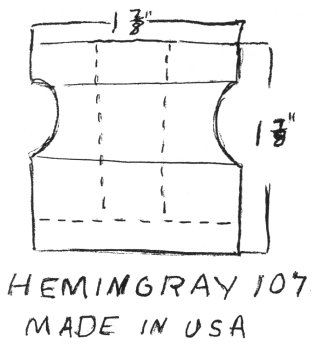
- - - - -
Dear Kevin,
You will find this insulator knob listed in Francis Terrill's book Hemingray
Insulators Priced, page 92. She lists it at $8.00 in light green.
Dora
Dear Mrs. Harned:
I was just reading your April 1973 issue of Crown Jewels and I couldn't help
noticing the "Wrought Iron Universal Bracket" on the top of page 19. We
just moved to California from northern Illinois and where we used to live, the
power company used to use these brackets to connect their lines to the houses
and buildings around our town. When the company modernized, they re-connected
all the lines, and left all the old insulators, unused, right on the buildings.
I remember finding some pretty good glass on this type of peg.
But what is so unique about these brackets is that the insulator screws on to
a heavy metal spring instead of the standard threaded peg. (You can see one of
these springs in the picture.) When a lineman screws an insulator on to it, the
spring contracts, but when one of us poor collectors tries to unscrew it, the
spring expands, so it is almost impossible to get the insulator off! And after
many years out in the elements ... The only way I know of to get your insulator
off is to hacksaw the pin off, with the insulator still on it, carry it home,
and put it in acid for a week or two.
Then there was the time I tried to force the thing off--the pin expanded, and
the insulator just shattered! It was a H.G.CO. CD-160 with drips, 100% mint
(which is hard to find). No great loss, but too bad, anyway.
Well, this is one way to put an insulator on the peg for good! Just thought
you might be interested. Keep up the good work on the magazine.
Sincerely,
Paul Greaves
Carmichael, California
Dear Dora,
I am writing about an insulator (or believed to be an insulator)
that I recently bought at a flea market. It stands about 2" tall and
1-1/2" wide at the top and 2-1/16" wide at the bottom. It is
threadless and crude in construction. The pin hole runs through the top and
bottom. There are many weather checks and bubbles, also a mold line on both
sides running from top to bottom. It is aqua in color and in mint condition. The
person I bought it from said it is a lightning rod insulator, but I'm not sure.
Any information as to what it is and its approximate value would be greatly
appreciated.
Jeff Blick
Sparta, N. J.
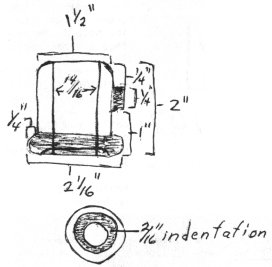
A lightning rod insulator I'm sure, but the value will have to come from
someone other than me.
Dora
Dear Dora:
Until recently, I was quite convinced that those insulators with the embossed
"bar" were all Hemingray in manufacture. Now I don't think they all
are. While at the Toledo show in March I saw a CD 151 embossed with a bar on
each side. The owner proudly proclaimed it as a K.C.G.W. I wasn't going to
argue, because it didn't look like any Hemingray CD 151 I had ever seen. It was
shorter and fatter. He also had a CD 151 with a (7) seven embossed on either
side. This was something I never heard claimed to be a Hemingray, and it was the
exact shape and color of the other CD 151 with bars.
I traded to Jerry Turner a CD 106 with embossed 7 on each side and since then
have been able to come up with another one as well as a CD 106 with bars. You
guessed it. The two are identical in shape with a distinctive and unique upper
wire lip that comes down to a point. Neither color resembles anything that I've
seen from Hemingray, either, the bar being a light green, and the 7 being an odd
dull dark green. (See sketches below.)
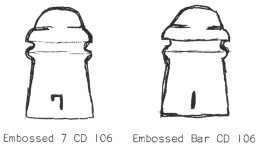
I also have the short squatty CD 133 with bars, but I'm beginning to wonder
if this isn't another short fat copy of a Hemingray product made by K.C.G.W. I
also have a CD 124 with F-bar, B-crescent which is identical to an 1871
"4" I have.
So I think that this area is still in need of clearing up, at least for me.
Would appreciate any info. on bars or sevens. Also have more than one piece with
a crescent. By the way, I have a CD 102 pony marked with a bar on each side
that's supposed to be Canadian! Add to the confusion! Keep up the good work.
Thank you.
Dennis Stewart
Cincinnati, Ohio
Dear Dora:
I have some questions maybe you or some of the readers might answer for me. I
recently found in our area four Cal. Elect. Works Patent and one E.C.&M. in
mint condition except for a fracture on one Cal. and small chip on another. The
first question is about the Calif. embossing. Three have lettering 3/16"
high, and one a little over 1/4" high. Is there any difference in rarity?
The second question concerns the E.C.&M. It is 3-5/8" tall, and I'm
curious to know if shorter ones exist. The thread mandrel top appears to be
directly under the crown surface, as close as I can measure, about 1/16"
below. I'll certainly appreciate any information, and many thanks for a fine
publication. We anticipate its arrival greatly each month.
Dave Gularte
300 Reata St.
Salinas, CA 93901
- - - - -
Dear Dave,
We have several specialists in E.C.&M.'s and Cal. Elect. Works here on
the West Coast, and I feel that they are more qualified to answer these
questions than I am. I'm sure you will hear from them.
Dora
| 